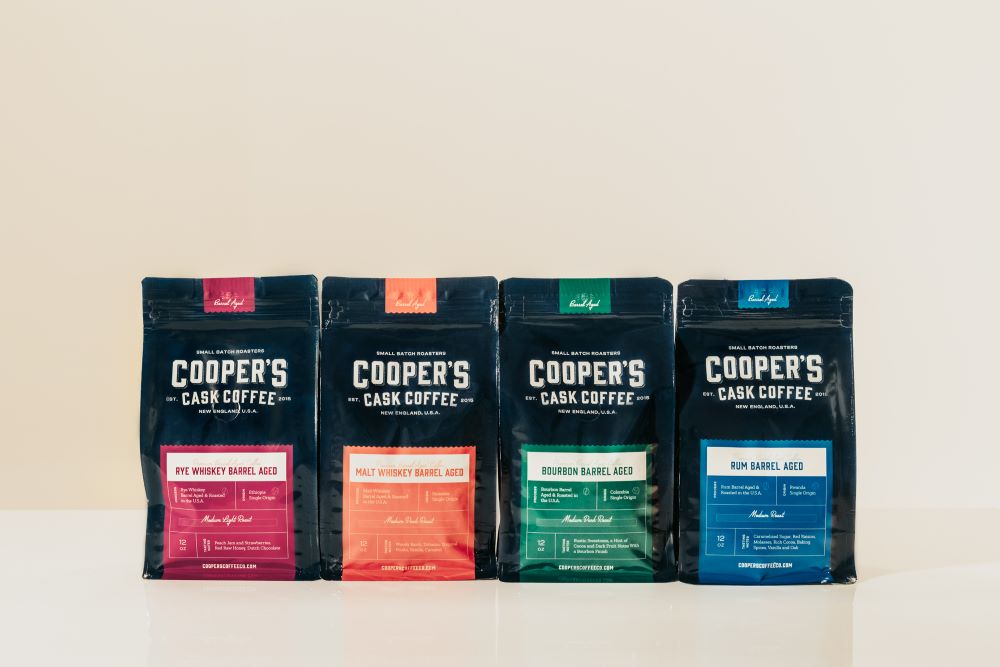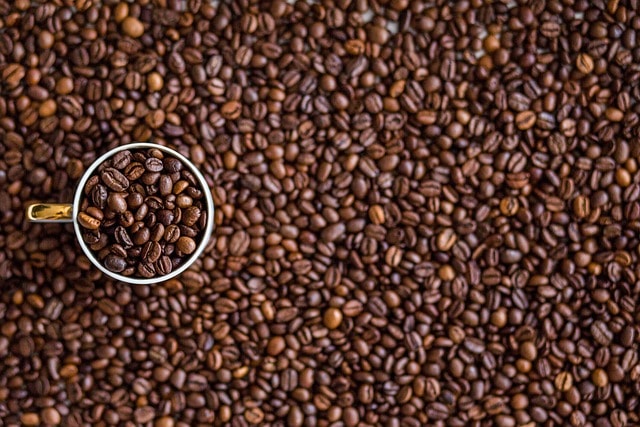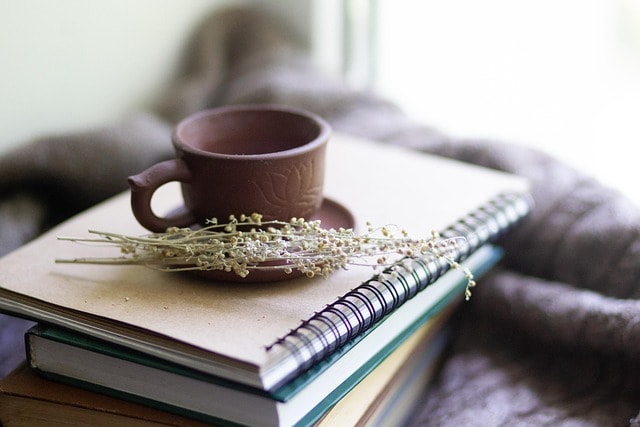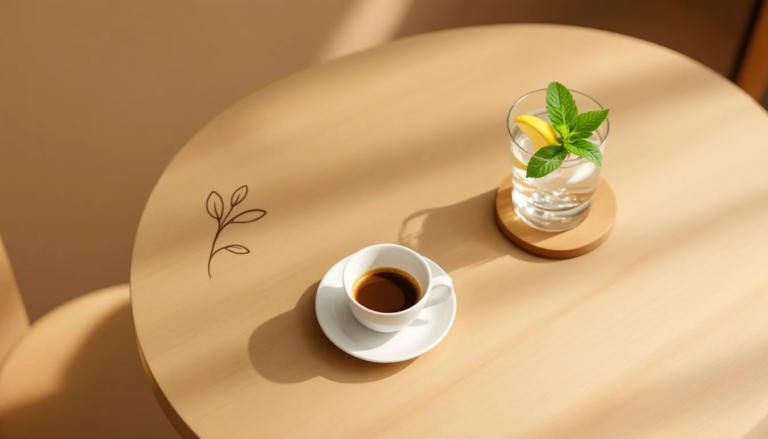When you drink Cooper’s Cask Coffee by itself, black, you notice the subtle flavors of fruits and berries. A natural sweetness like caramelized sugar. Even earthy tones like plum or fresh tobacco.
We require one constant thing from all our beans: that they make a great cup of coffee without chemicals, syrups, or other additives. Then, with our barrel aged coffee, you get even more for your senses—with no syrups, no chemicals, and no additives.
Now, we don’t judge if you like to add cream or sugar or whatever to your joe. You do you! Just keep in mind that if coffee doesn’t start with a great flavor, the extras aren’t adding to your cup. They’re helping you hide from it.
Our barrel aging technique infuses extra flavor for a new coffee experience. Try our delicious choices— from malt whiskey to rum, bourbon, rye whiskey, wine & more. Purchase the kind you like, or as a box set of different flavors to sample. You can gift a sampler set to someone else for delight at their first cup.
You can even subscribe for monthly shipments of the freshest coffee this side of your cup. Read on about how we make our barrel aged coffee for the freshest taste in town..
What is barrel aged coffee?
Barrel aging coffee doesn’t mean fermentation. Rather, barrel aged coffee is coffee that’s spent weeks or months in a retired barrel originally used to age whiskey, bourbon, rum, or wine.
How Barrel Aging Works
Seems simple enough, right? You stick coffee beans in a barrel for a while. Aaaand?
On the outside, yes, it seems simple. But the process requires several steps that gourmet coffee lovers understand and appreciate.
The Barrel
Choosing the right supplier of these retired barrels is very important. It has to be a company conscientious not only of the quality of spirits kept in those barrels, but also the earth-conscious sourcing of them.
We get to infuse our top-quality beans using award-winning whiskey barrels from Sons of Liberty Spirits (South Kingstown, RI) and rum barrels from Thomas Tew Rum (Newport, RI), among others.
These barrels were originally chosen to create the complex flavor notes of the wine, bourbon, rum and whiskey finished in them. We discovered that barrel aging the unroasted coffee beans in these used barrels also enhances and intensifies the natural flavor of the beans.
The Beans
If you start with bad coffee beans, you get bad coffee results. That’s why we only source the best, single origin coffee beans. We choose beans whose flavor notes and subtleties best match and complement the flavors imparted by the aromas left behind in the empty barrels.
Why use green coffee beans?
Green coffee beans have a surprising knack to take on the taste characteristics of their storage containers. For example, if you leave green coffee beans in a burlap bag too long, your coffee will have strong hints of burlap. But if you put them into retired whiskey, bourbon, rum, and wine barrels? You get magic.
The Roast
Because these barrels once contained spirits, there could be some residual alcohol that gets pulled into the bean. Our roasting process ensures you not only receive a perfect bean, but it also removes any alcohol from the bean and therefore the flavor profile.
We don’t roast the beans until the order is received, rather than creating a stockpile of roasted beans. You see, once the green coffee gets roasted, the clock starts and your coffee has about 7 days to retain peak freshness.
So does it take more time to roast in small batches like we do? You bet. Does it make sure your beans are at their peak freshness when you get them? Absolutely.
Now you know why we only roast what is ordered. Cooper’s Cask Coffee never sits roasted in warehouses or on retail shelves for many weeks or months. To prove it, our master roaster hand-writes the roast date on every package.
When you unbox your Cooper’s Cask Coffee, you will know the freshness of your beans.
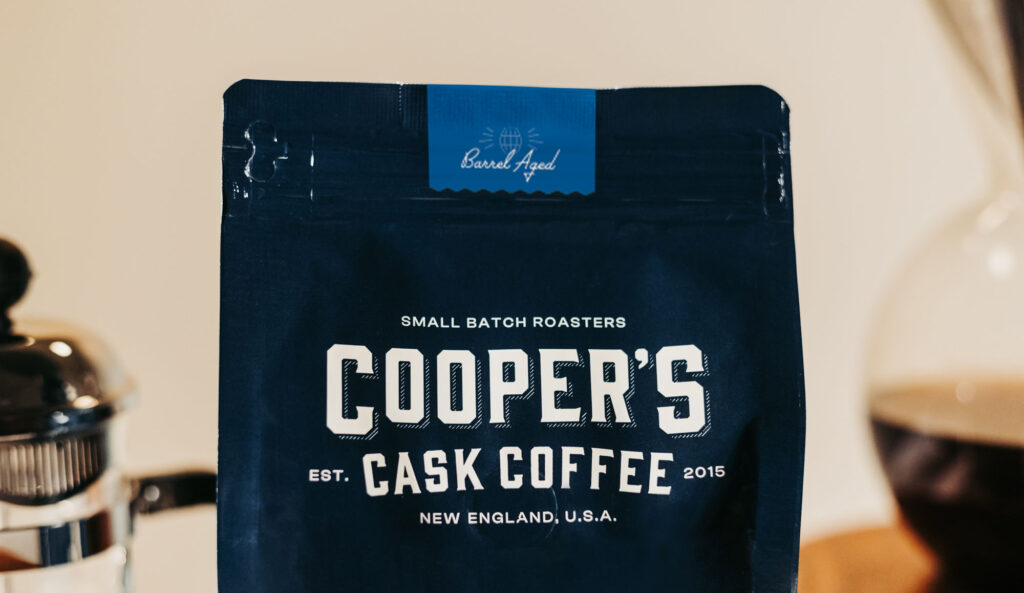
A Deeper Look at the Barrels
How is it that these oak barrels we use for barrel aged coffee can impart their spirit flavors so well? We’ve explained the use of green coffee beans vs roasted, and how those beans absorb flavors better, and protect the coffee freshness.
The barrels themselves have spent several years on the job, creating craft spirits and wines. Where did the barrels come from? Coopers.
And yes, that’s how we got our name.
How Coopers Make Barrels
A cooperage starts by picking the right wood—American oak. This is an interesting process, too, because not all American oak will impart the same flavors. Just like how grapes grown in different locations and climates create distinctly different notes in a bottle of wine, the choice of American oak shapes the final flavor of the spirit—and of our barrel aged coffee.
The oak arrives at the cooperage in dried slats, also called staves. The cooperage then places each stave, by hand, into a machine that shapes it correctly for turning it into a barrel.
When they’re ready, the cooper puts the staves into a mise en rose, a special ring that holds them in place. Then metal rings are put around the outside of the barrel to squeeze it into the barrel shape.
During this process, the staves are heated by immersion in boiling water, a steam bath, or by flame heating. This helps to not only make the wood more pliable for shaping, the water or steam can also help remove further tannins from the wood.
Get Fired Up
Depending on the cooperage, there are several ways to char the inside. Regardless of how it’s done, the inside of the barrel achieves a depth of char that will shape the flavor of the liquid stored in it.
For example, a more deeply charred—or “toasted”—barrel could create a burgundy wine. Higher toasting also lends the spirit more spicy and smoky notes, and possibly a vanilla tone. Lightly toasted barrels add more tannin and oak flavoring.
The wood and the charring create the environment for exciting results. Several other factors surrounding the barrel also impact the final product, including the barrel’s size, its shape, and even the environment (heat, humidity) in which the barrel sits while the spirits mature inside it.
The Lifespan of a Barrel
Did you know that the US government has regulations over which barrels can be used to make whiskey? It’s true. According to regulations from the TTB—the Alcohol and Tobacco Trade and Tax Bureau—bourbon must be aged in a new, charred, American oak barrel.
That aging requires 2 years minimum. And for it to be called bourbon, it must be made here in the United States. And it’s not just bourbon that must be aged in new charred “containers” (it does go on to say, specifically, “barrels”). Added to the list are rye, malt, and wheat whiskey.
Part of the reason is quality. If the barrels are reused, not only do spirits producers run the risk of inconsistent product taste from batch to batch, they can also dilute the crucial flavoring elements from the barrels.
Think of it like reusing a tea bag. The first cup is full of flavor, the second less so, and by the time you reach the 3rd or 4th use, you may not really have tea at all. You just have a cup of hot water with hints of “teaness.”
There’s a history behind the new-charred barrel regulations. We won’t delve into it here, but that history includes prohibition, public safety, revival of the bourbon art form, and maybe just a teensy bit of pressure from the coopers union.
Regardless of what led us here, the end result is the U.S. producing some of the best bourbons and whiskeys in the world, not to mention world class wines.
Life After Bourbon
So in America, it’s one and done for these barrels to make bourbon and specific whiskeys.
That means after their first use as a bourbon barrel, the barrel cannot be used for consecutive bourbon storage, right?
Wrong. They find a new purpose making spirits outside of the United States.
Used bourbon barrels find their ways to spirits makers across the globe. Scotch whiskey, Canadian Whiskey, Irish Whiskey, Caribbean rum, Mexican tequilas, and other spirits are finished in these barrels in countries where the re-use isn’t prohibited by law.
But wait, there’s more. Brewers like to use these barrels to lend certain flavor notes to stouts, porters, wines, ciders, and more. And industries outside of distilled spirits also use these barrels to make syrups, honeys, and many other things—including Tabasco sauce, which is aged for 3 years exclusively in used barrels from Jack Daniels.
How many times is a whisky barrel used?
Generally speaking, outside of the US these barrels can be reused the following number of times for each specified spirit:
- Bourbon—1 time
- Wine—3 times
- Whiskey—4 times
- Rum—7 times.
Sometimes the char is kept in these barrels for flavoring, and sometimes it’s removed to get back down to a fresher layer of oak. It all depends on the goals of the secondary market user.
Maybe, just maybe—they’re using it for barrel aged coffee. Who knew?
Related: getting to know our barrel aged coffee flavor profile.
Some Surprising Facts About Barrels
We talk a lot about bourbon barrels, because so many other spirits industries use them after they’ve made their bourbon. Some of the other spirits might surprise you in how they came to be barreled.
Rum Barrels
Did you know rum being finished in barrels wasn’t part of the original process?
In the 1600’s, Caribbean sugar farms made sugar by crushing the cane, boiling it, and then letting that solution dry in clay pots.
As the liquid cured, a thick, dark goo would seep from the pots. This later became known as molasses, but in the beginning it was known as gross. The farmers threw it away or tossed it into the sea.
Then, some blessed soul fermented the goop, and through final distillation created rum.
How did barrels get involved? At first, they were only used to transport rum. But leave it to pirates—errrr, sailors—to discover that the longer the rum stayed in the barrel, the better it tasted. And suddenly, the barrels became part of the creation process rather than just a conveyance.
In modern times, used spirits barrels are scraped and possibly re-charred, and those become rum barrels. And yes, the “learned” flavors from the barrel’s previous use can become part of the rum’s flavor notes.
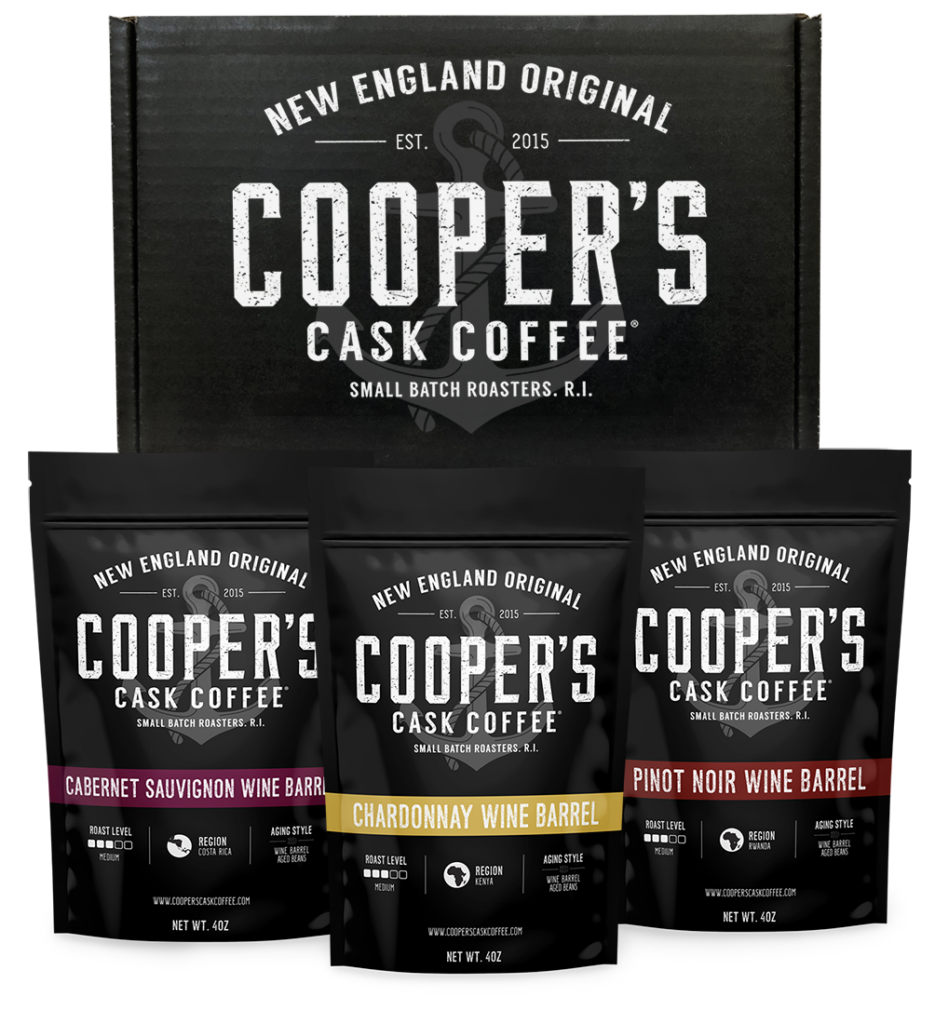
Wine Barrels
After their life as a bourbon barrel, wine barrels can only be used about 3 times before the wood becomes “neutral.” That means the barrels no longer impart their own flavor to the wine—such as wood tannins, and the flavoring effects of the char depth (if charred).
So when you enjoy an “oaky” wine, it has probably been aged in a newer barrel, where the tannins haven’t been fully leached out of it.
What makes a barrel a barrel?
Size matters, when it comes to what constitutes a barrel.
- Standard American Barrel: 53 Gallons. This barrel size is considered a standard barrel, and is often used for whiskey and bourbon storage.
- Hogshead: 63 Gallons. This bigger barrel is created from disassembled American barrels. They take 5 American barrels and turn them into 4 Hogshead barrels.
- Sherry Butt: 132 Gallons. Imagine an American barrel that plays basketball. This barrel is taller and more slender. They include the name Sherry because, surprise surprise, they’re used to make sherry. However, they often get used for aging whiskey, where the sweetness of the sherry can add pleasant hints to the whiskey as it ages.
- Quarter Cask: 13 Gallons. These are 1/4 the size of the American barrel. They frequently get used to finish a spirit at the end of the maturation process.
Empowered Barrels at Cooper’s Cask Coffee
We love infusing our green coffee beans in our hand-chosen bourbon, whiskey, rum, and wine barrels. But are the barrels re-usable for us after an aging is finished?
Yes. Because we re-empower the barrels. It’s the tastiest recycling you’ll ever enjoy.
We take our barrels and re-infuse them with the quality spirits they helped create in the first place. After they’ve re-absorbed the essences, we’re able to use them to once again create delicious barrel aged coffee.
Why go to all that trouble?
After this crash-course on the life of a barrel, you might be wondering why we would work so hard to impart delicious, gourmet flavor into our barrel aged coffee through natural means?
Here’s the ugly truth: other companies often use flavors to make bad or stale coffee taste better.
When you buy a package of “french vanilla caramel pumpkin spice maple bananas foster latte” coffee beans in your grocery store, you’re pretty much guaranteed that those flavors didn’t arrive from natural aromatics prior to roasting.
When Coffee Is Flavored to Cover the Real Flavor
What you’re getting is coffee beans that got coated, after roasting, with flavor chemicals in a solvent (such as propylene glycol).
This industrial mix is dumped on the beans, and they’re tossed and rolled around to get fully coated. It’s much more cost effective for the coffee producer to utilize “artificial” flavors for a taste-adjacent experience, rather than devote the time and effort to naturally infuse them.
Plus, the industrial method allows large-scale action. We’re a small batch coffee company, with a penchant for exactitude.
With these mass-produced flavored coffees, you lose most of the true flavor notes of the original bean as they get buried under artificial flavors. Again, we don’t judge anyone on how they like to enjoy their coffee. If we didn’t love a delicious bean along with natural flavor additions, we wouldn’t make a barrel aged coffee that’s considered to be one of the best.
But we do recommend that if you’re going to splash in extras, try tasting the natural flavor of the coffee itself first, and then adding real ingredients as you wish. Want to add cream? Do it. Vanilla? Plunk in a vanilla stick (it’s amazing). Or how about real caramel dissolved in your cup of joy.
You can learn which flavors compliment which beans. Yes, we geek out on that, but the end results speak for themselves.
As for bananas foster coffee? Well…maybe bananas foster on the side with a Cooper’s Cask Coffee Sumatran espresso. That’s what we call yum.
Related: our top 5 coffee cocktails to lift your spirits and your experience!
Barrel Aged Coffee from Cooper’s Cask Coffee
Our Signature Barrel Aged Series coffees will surprise and delight anyone who enjoys good coffee, from the morning-brew person to the java connoisseur.
Each set of green coffee beans are aged for months in our specialty casks and barrels. We add zero artificial flavors or additives. When you place your order, you can choose from whole beans or a specific grind.
We roast each order’s batch just before bagging and shipping, so that you will always get the freshest coffee possible. And we offer a 100% satisfaction guarantee. If for any reason you’re not satisfied with our imported, high-end coffee beans, just let us know within 30 days and we’ll replace it with a different coffee, or give you a full refund, your choice!
Check out our choices for a distinctive, complex new style of coffee, and contact us with any questions.
Single Malt American Whiskey Barrel Aged Coffee
Also called our “Uprising Coffee,” we start with our single source Sumatra coffee bean. It comes from the sub-region of Lintong, chosen because of the complementary tasting notes of woody earth and mild sweet tobacco with a hint of tropical fruit.
Using barrels from Uprising, a single malt American whiskey from Sons of Liberty Whiskey, we age the green Sumatra beans for additional flavor and aroma notes of vanilla and caramel sweetness. We give this coffee a medium-dark roast for a bold coffee experience.
Thomas Tew Rum Barrel Aged Coffee
Imagine a delicious cup of Rwanda single origin coffee, medium roasted, with hints of dark toffee and molasses, along with a caramel sweetness and slight spiciness. That’s what you get with our Thomas Tew Rum Barrel Aged Coffee.
We achieve this flavor profile by aging the green Rwanda beans in Thomas Tew Rum Barrels from Newport, RI. This coffee delivers an incredibly smooth experience, with a rich cocoa complexity. This is another favorite for making espresso.
Kentucky Bourbon Barrel Aged Coffee
We start our Bourbon Whiskey Barrel with Colombian Grade 1 single origin coffee beans. Then we load them into Kentucky bourbon whiskey barrels and age them for months, so that they can be infused with the rustic sweetness and bourbon finish of the barrels.
Once the beans are ready, Cooper’s Cask Coffee gives them a dark roast per order, and delivers them to you as whole beans or the grind of your choice.
Rye Whiskey Barrel Aged Coffee
This delicious brew begins with Ethiopian dry processed single origin green coffee beans, aged in Sons of Liberty “Battle Cry” Rye Whiskey Barrels.
The dry process involves drying out the coffee cherries under the sun, rather than stripping the cherries after picking. This intensifies the flavor of the cherry into the coffee bean. The barrels we use imbue accents of dark fruits, honey, and chocolate, with a floral room note and a slightly sweet finish.
Our Rye Whiskey Barrel Aged Coffee delivers intense aromas and complex flavors in each cup.
Related: discover how we make our barrel aged coffee!
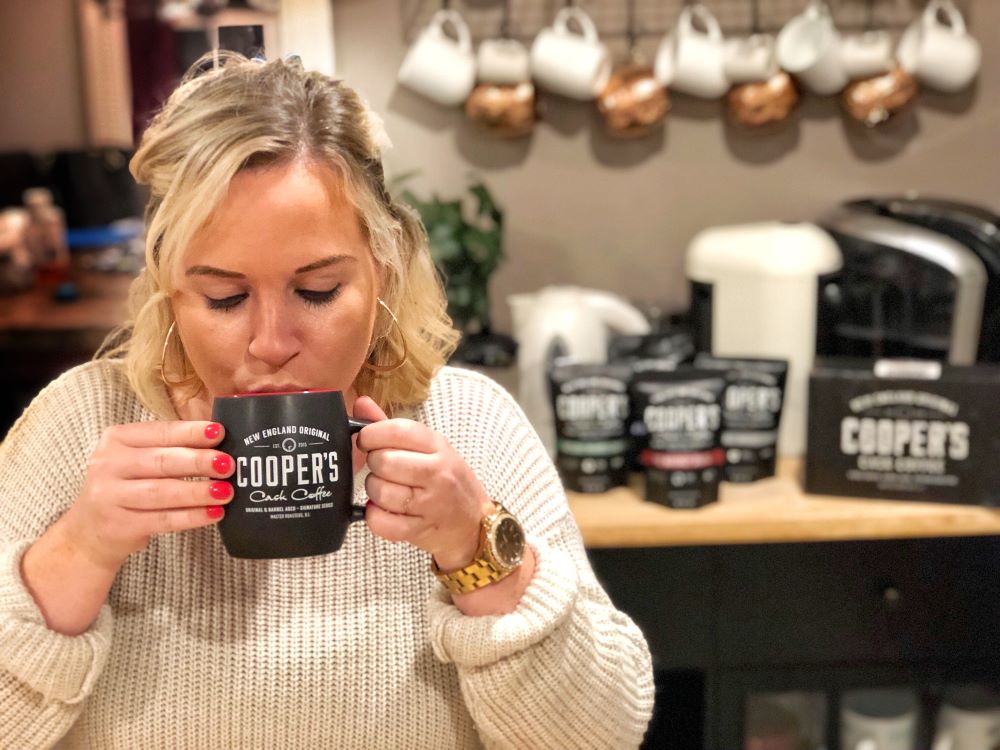
Chardonnay Wine Barrel Aged Coffee
Our wine barrel aged coffees offer unique flavor profiles for a new experience in your cup. Cooper’s Cask Coffee Chardonnay Wine Barrel Aged Coffee starts with Kenyan AA single origin coffee beans, of the Bourbon varietal.
The tart and dark fruit notes of the coffee do justice to the Chardonnay infusion. The final beans are roasted to a slightly darker medium to highlight the bitter-sweet chocolate and dark cherry sweetness.
Cabernet Sauvignon Wine Barrel Aged Coffee
Cooper’s Cask Coffee Cabernet Sauvignon Wine Barrel Aged Coffee ages Costa Rican single origin beans in cabernet sauvignon wine barrels for a beguiling complexity of flavors, including honey, chocolate, and molasses. The medium-roast process further enhances these flavors, including a toasted oak finish.
Pinot Noir Wine Barrel Aged Coffee
Our Pinot Noir Wine Barrel Aged Coffee takes beautiful pinot noir wine barrels, and fills them with single origin Rwanda green coffee beans. After a few months, the beans are removed and medium-roasted for a rustic sweetness that develops on the palate to a heavy sweet body.
The Rwandan beans are high-grown at elevations of roughly 5900 feet to 6100+ feet in an area known as the “land of 1000 hills.” This Bourbon varietal lends a balanced sweetness with a slightly tart, zingy finish.
Try a Box Set
Not sure which barrel aged coffee to try first? Try one of our Cooper’s Cask Coffee Box Sets. We have plenty of options, from 3 bags to 4 bags, plus single origin quad packs. You can try out the flavors, and find your new all-time favorite. It’s time you looked forward to your next cup!
Love coffee? So do we.
The goal of Cooper’s Cask Coffee is to provide you with the world’s best single origin coffee beans from around the globe, roasted to perfection. From our Single Origin Coffee to our Barrel Aged Coffee, each cup tells a complex, delicious story of the journey from earth to barrel to roaster to “mmmmmmm.”
We believe in our quality and satisfaction, so much so that we always offer a 100% money back guarantee. Should your coffee choice end up not being your preference, simply ask for a refund or to try another of our coffee choices at no charge (shipping included!).
Let’s toast to the roast. Cooper’s Cask Coffee. Small batch, big satisfaction.
Sign up for our email list and get 10% off your first order!
